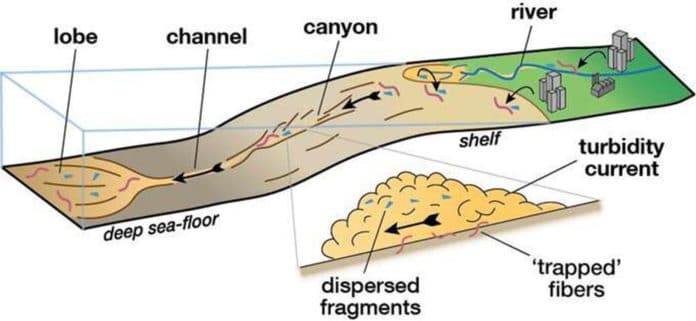Much of the macro- and microplastic in the ocean ends up on the seafloor, with some of the highest concentrations reported in submarine canyons that intersect the continental shelf and directly connect to terrestrial plastic sources.
Gravity-driven avalanches, also called turbidity currents, are the primary process for delivering terrestrial sediment and organic carbon to the deep sea through submarine canyons. However, how turbidity currents transport microplastics in the deep ocean is poorly understood.
To understand the process, a new study using flume experiments has shown that submarine sediment avalanches sort different types of microplastics—burying some and moving others vast distances across the seafloor.
The study- conducted in collaboration with the Universities of Manchester, Utrecht, and Durham, and the National Oceanography Centre- may help foresee the location of future seafloor microplastic hotspots, which in turn could help direct research into the impact of microplastics on marine life.
Scientists noted, “We found that microplastics can be moved by gravity-driven sediment flows, which can travel thousands of kilometers over the seafloor.”
During experiments, scientists mixed Quartz sand with microplastic fragments and fibers. They then released them in a flume tank. Using techniques developed by Dr. Ian Kane, a researcher from the University of Manchester, scientists observed the sediment carried within these flows and deposited on the seafloor. They then observed the samples at The University of Manchester Geography Laboratories.
Concentrations of microplastic fragments were concentrated in the lower parts of the flow, while microplastic fibers were distributed throughout the flow and settled more slowly. The larger surface-to-volume ratio of grains is thought to be the reason they are more evenly distributed. The high concentration of microplastic fibers in sand layers at the base of the flow is believed to be because they get more easily trapped by sand particles.
Dr. Ian Kane said: “This is in contrast to what we have seen in rivers, where floods flush out microplastics; the high sediment load in these deep ocean currents causes fibers to be trapped on the seafloor, as sediment settles out of the flows.”
These experiments have revealed the ability of turbidity currents to transport and bury plastics. Scientists are planning for further research that will involve sampling and monitoring deep-sea submarine canyon, to understand how robustly these experimental findings can be applied to natural systems and the effects on deep-sea ecosystems.
Journal Reference:
- Transport and Burial of Microplastics in Deep-Marine Sediments by Turbidity Currents. DOI: 10.1021/acs.est.9b07527
